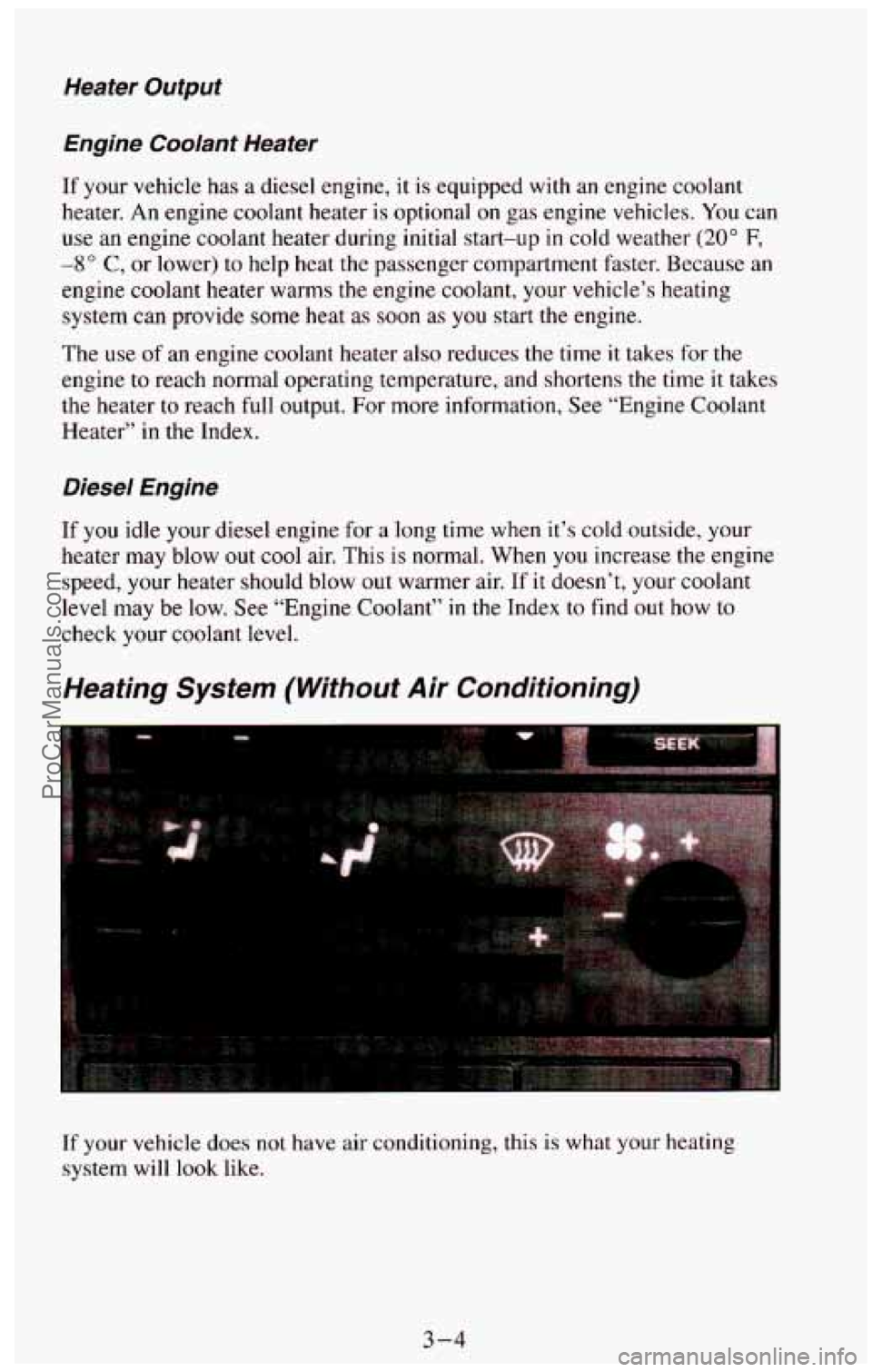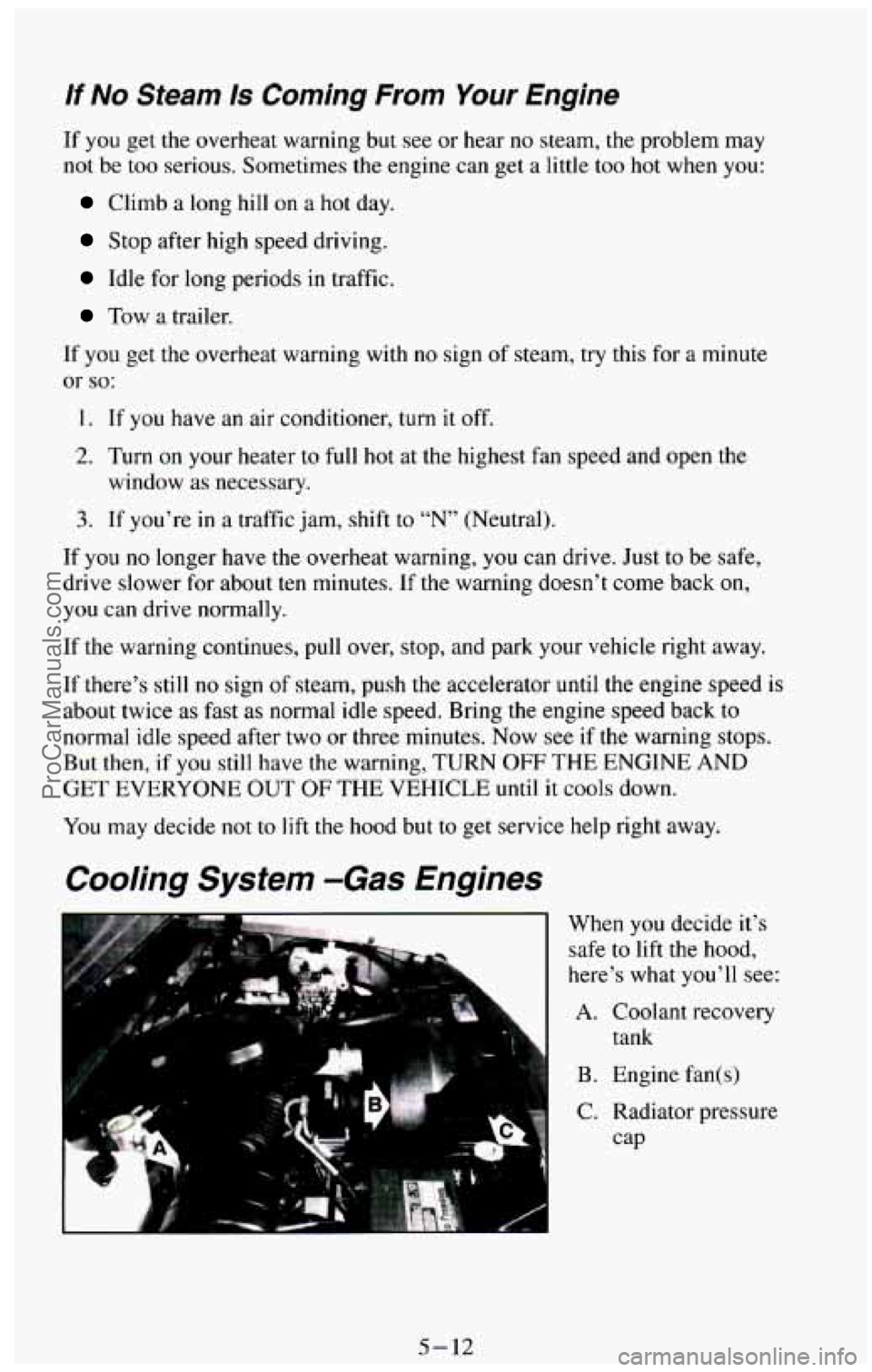Page 141 of 385

Heater Output
Engine Coolant Heater
If your vehicle has a diesel engine, it is equipped with an engine coolant
heater. An engine coolant heater
is optional on gas engine vehicles. You can
use an engine coolant heater during initial start-up
in cold weather (20” F,
-8” C, or lower) to help heat the passenger compartment faster. Because an
engine coolant heater warms the engine coolant, your vehicle’s heating
system can provide some heat as soon as you start the engine.
The use
of an engine coolant heater also reduces the time it takes for the
engine to reach normal operating temperature, and shortens the time it takes
the heater
to reach full output. For more information, See “Engine Coolant
Heater” in the Index.
Diesel Engine
If you idle your diesel engine for a long time when it’s cold outside, your
heater may blow out cool air. This is normal. When you increase the engine
speed, your heater should blow
out warmer air. If it doesn’t, your coolant
level may be low. See “Engine Coolant”
in the Index to find out how to
check your coolant level.
Heating System (Without Air Conditioning)
If your vehicle does not have air conditioning, this is what your heating
system will look like.
3-4
ProCarManuals.com
Page 190 of 385
Winter Driving
Here are some tips for winter driving:
0 Have your vehicle in good shape for winter. Be sure your engine
coolant
mix is correct.
0 You may want to put winter emergency supplies in your vehicle.
Include an ice scraper, a small brush or broom, a supply
of windshield
washer fluid, a rag, some winter outer clothing, a small shovel, a flashlight,
a red cloth, and a couple
of reflective warning triangles. And, if you will be
driving under severe conditions, include a small bag of sand, a piece
of old
carpet or a couple of burlap bags to help provide traction. Be sure you
properly secure these items in your vehicle.
Driving on Snow or Ice
Most of the time, those places where your tires meet the road probably have
good traction.
However, if there is snow or ice between your tires and the road, you can
have a very slippery situation. You’ll have a lot less traction or “grip” and
will need
to be very careful.
4-31
ProCarManuals.com
Page 213 of 385
Towing From the Rear
Engine Overheating
You will find a coolant temperature gage on your vehicle instrument panel.
If you have a diesel engine, you will also find a low coolant light on your
instrument panel.
5-10 ProCarManuals.com
Page 214 of 385
If Steam Is Coming From Your Engine
I NOTICE:
If your engine catches fire because you keep driving with no
coolant, your vehicle
can be badly damaged. The costly repairs
would not be covered
by your warranty.
5-11 ProCarManuals.com
Page 215 of 385

If No Steam Is Coming From Your Engine
If you get the overheat warning but see or hear no steam, the problem may
not be too serious. Sometimes the engine can get a little too hot when you:
Climb a long hill on a hot day.
Stop after high speed driving.
Idle for long periods in traffic.
Tow a trailer.
If you get the overheat warning with no sign of steam, try this for a minute
or
so:
1. If you have an air conditioner, turn it off.
2. Turn on your heater to full hot at the highest fan speed and open the
3. If you’re in a traffic jam, shift to “N’ (Neutral).
window
as necessary.
If you
no longer have the overheat warning, you can drive. Just to be safe,
drive slower for about ten minutes. If the warning doesn’t come back on,
you can drive normally.
If the warning continues, pull over, stop, and park your vehicle right away.
If there’s still
no sign of steam, push the accelerator until the engine speed is
about twice as fast as normal idle speed. Bring the engine speed back to
normal idle speed after two or three minutes. Now see
if the warning stops.
But then, if
you still have the warning, TURN OFF THE ENGINE AND
GET EVERYONE OUT OF THE VEHICLE until it cools down.
You may decide not to lift the hood but to get service help right away.
Cooling System -Gas Engines
When you decide it’s
safe to lift the hood,
here’s what you’ll see:
A. Coolant recovery
“I tank
B. Engine fan(s)
C. Radiator pressure
cap
5-12
ProCarManuals.com
Page 216 of 385
If the coolant inside the coolant recovery tank is boiling, don’t do anything
else until it cools down.
P
The coolant level
should be at or above
the
COLD mark. If it
isn’t,
you may have a
leak in the radiator
hoses, heater hoses,
radiator, water
pump
or somewhere else in
the cooling system.
NOTICE:
Engine damage from running your engine without coolant isn’t \
covered
by your warranty.
If there seems to be no leak, start the engine again. See if the fan speed
increases
when idle speed is doubled by pushing the accelerator pedal down.
If it doesn’t, your vehicle needs service. Turn off the engine.
5-13 ProCarManuals.com
Page 217 of 385
How to Add Coolant to the Coolant Recovery Tank
If you haven’t found a problem yet, but the coolant level isn’t at or above
the
COLD mark, add a 50/50 mixture of clean water (preferably distilled)
and a proper antifreeze at the coolant recovery tank. (See “Engine Coolant”
in the Index for more information about the proper coolant mix.)
NOTICE:
In cold weather, water can freeze and crack the engine, radiator, \
heater core and other parts.
Use the recommended coolant.
5-14
ProCarManuals.com
Page 221 of 385
6. Start the engine
and let it run until
you can feel the
upper radiator
hose getting hot.
Watch
out for the
engine fan(s).
By this time the coolant level inside the radiator filler neck may be
lower.
If the level is lower, add more of the proper mix through the
filler neck
until the level reaches the base of the filler neck.
8. Then replace the
pressure cap. At
any time during
this procedure
if
coolant begins to
flow out of the
filler neck,
reinstall the
pressure cap. Be
sure the arrows
on pressure cap
line up
like this.
Cooling System -Diesel Engines
When you decide it's
safe
to lift the hood,
here's what
you'll see:
A
A. Coolant surge
tank pressure cap
B. Engine fan(s)
C. Radiator
5-18
ProCarManuals.com